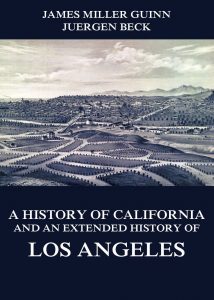A History of California and an Extended History of Los Angeles – James Miller Guinn
Few states of the United States have a more varied, a more interesting or a more instructive history than California, and few have done so little to preserve their history. In narrating the story of California, the author has endeavored to deal justly with the different eras and episodes of its history; to state facts; to tell the truth without favoritism or prejudice; to give credit where credit is due and censure where it is deserved. This accounts also for the prominence of Los Angeles in the second half of this volume. The consolidation of Los Angeles city and the cities of Wilmington, San Pedro and Hollywood has merged the history of these three into that of the Greater Los Angeles. The early history of these cities is given separately up to their consolidation.
All over this book is a real treasure chest and every single of its more than 400 pages is a must-read for the people of California and Los Angeles County.
Format: Paperback.
A History of California and an Extended History of Los Angeles.
ISBN: 9783849692049
Available at amazon.com and other venues.
Los Angeles Basics (from Wikipedia):
Los Angeles, officially the City of Los Angeles and often known by its initials L.A., is the cultural, financial, and commercial center of Southern California. With a census-estimated 2015 population of 3,971,883, it is the second-most populous city in the United States (after New York City) and the most populous city in California.
Located in a large coastal basin surrounded on three sides by mountains reaching up to and over 10,000 feet (3,000 m), Los Angeles covers an area of about 469 square miles (1,210 km2). The city is the focal point of the larger Los Angeles metropolitan area and the Greater Los Angeles Area region, which contain 13 million and over 18 million people, respectively, as of 2010, making it one of the most populous metropolitan areas in the world as well as the second-largest in the United States and the densest urban area in the United States. Los Angeles is also the seat of Los Angeles County, the most populated county in the United States. The city’s inhabitants are referred to as Angelenos.
Historically home to the Chumash and Tongva, Los Angeles was claimed by Juan Rodríguez Cabrillo for Spain in 1542 along with the rest of what would become Alta California. The city was officially founded on September 4, 1781, by Spanish governor Felipe de Neve. It became a part of Mexico in 1821 following the Mexican War of Independence. In 1848, at the end of the Mexican–American War, Los Angeles and the rest of California were purchased as part of the Treaty of Guadalupe Hidalgo, thereby becoming part of the United States. Los Angeles was incorporated as a municipality on April 4, 1850, five months before California achieved statehood. The discovery of oil in the 1890s brought rapid growth to the city. The completion of the Los Angeles Aqueduct in 1913, delivering water from Eastern California, later assured the city’s continued rapid growth.
Nicknamed the “City of Angels”, Los Angeles is known for its Mediterranean climate, ethnic diversity, and sprawling metropolis. The city is also famous as the home of Hollywood, a major center of the American entertainment industry, and one of the leaders in the world in the creation of motion picture, recorded music, and television productions. Los Angeles also has a diverse economy in culture, media, fashion, science, sports, technology, education, medicine, and research. A global city, it has been ranked 6th in the Global Cities Index and 9th in the Global Economic Power Index.
The city is home to renowned institutions covering a broad range of professional and cultural fields, and is one of the most substantial economic engines within the United States. The Los Angeles combined statistical area (CSA) has a gross metropolitan product (GMP) of $831 billion (as of 2008), making it the third-largest in the world, after the Greater Tokyo and New York metropolitan areas.
The city has hosted the Summer Olympic Games in 1932 and 1984 and is bidding to host the 2024 Summer Olympics and thus become the second city after London to have hosted the Games three times. The Los Angeles area also hosted the 1994 FIFA men’s World Cup final match as well as the 1999 FIFA women’s World Cup final match; both games were held at the Rose Bowl in the nearby city of Pasadena. The men’s event was watched on television by over 700 million people worldwide.
(The text of the last section was taken from a Wikipedia entry and is available under the Creative Commons Attribution-ShareAlike License.)
Publisher’s Note: This book is printed and distributed by Createspace a DBA of On-Demand Publishing LLC and is typically not available anywhere else than in stores owned and operated by Amazon or Createspace.

